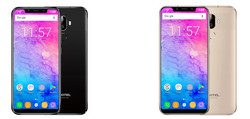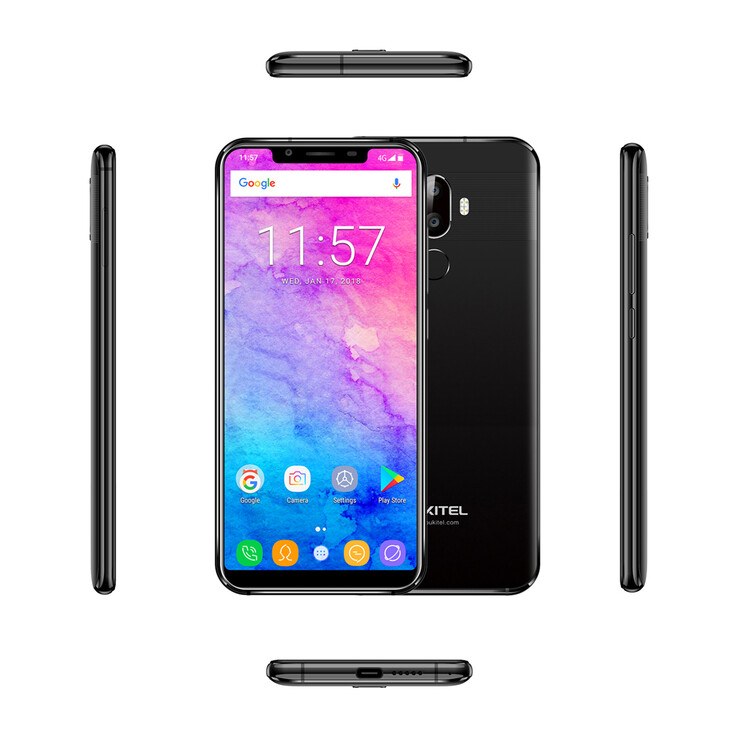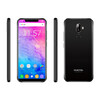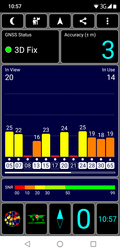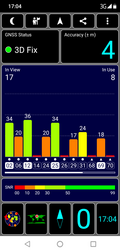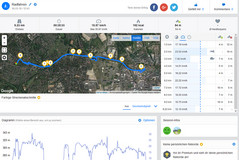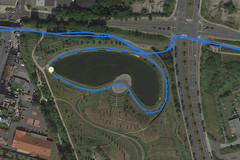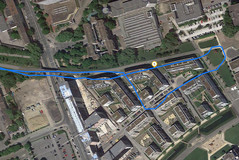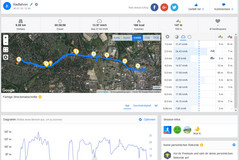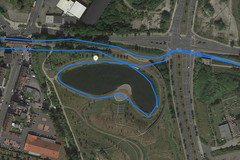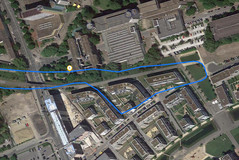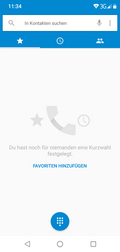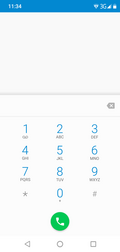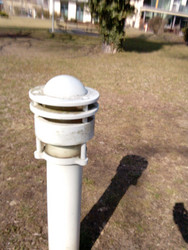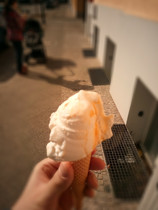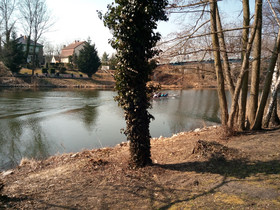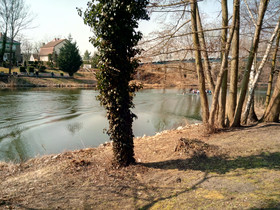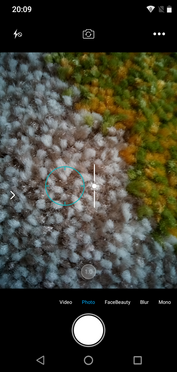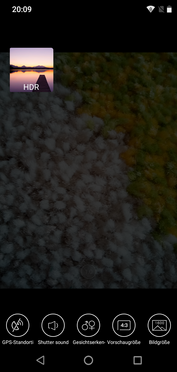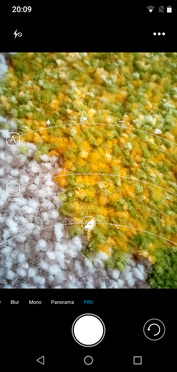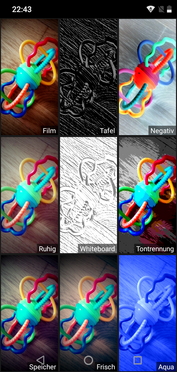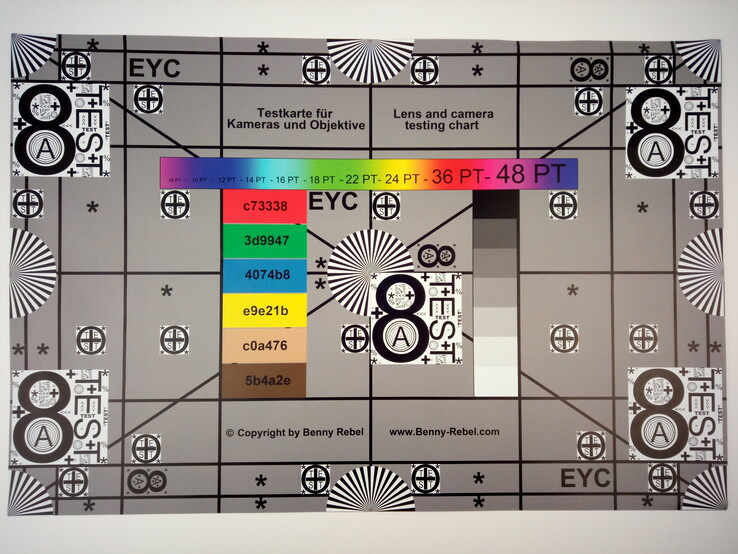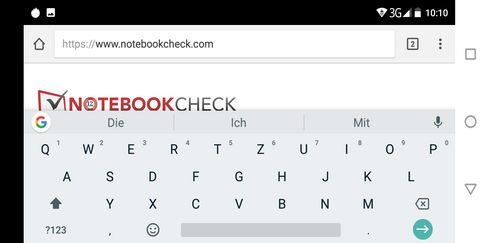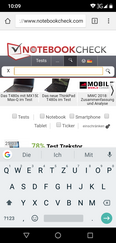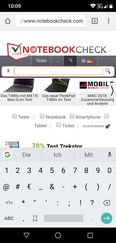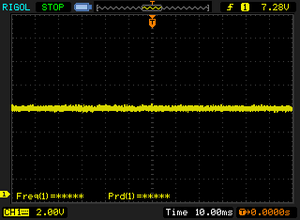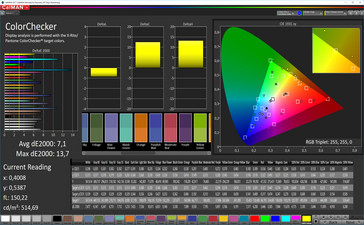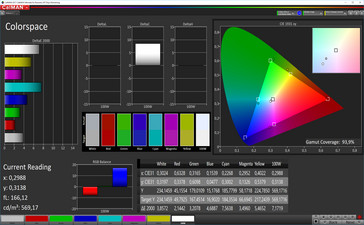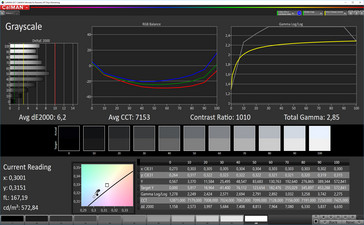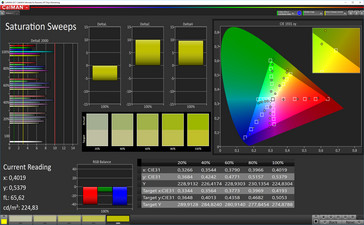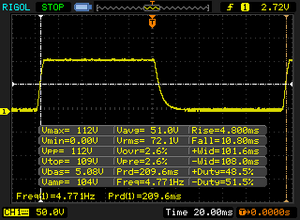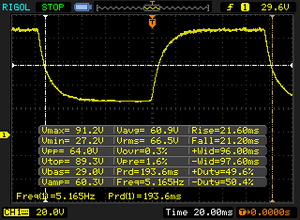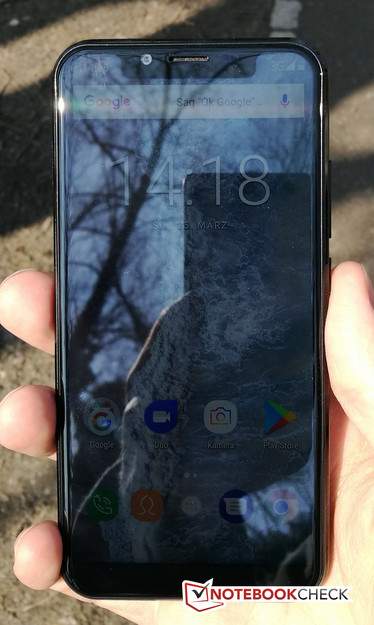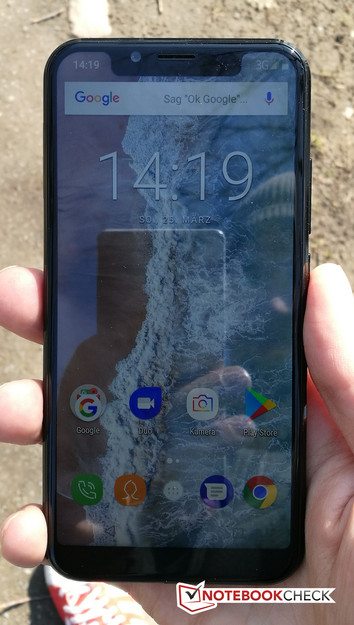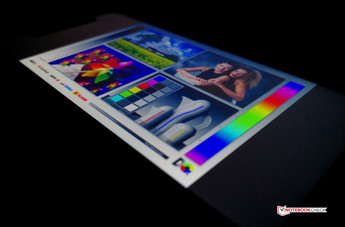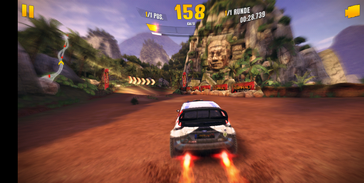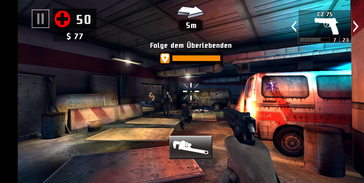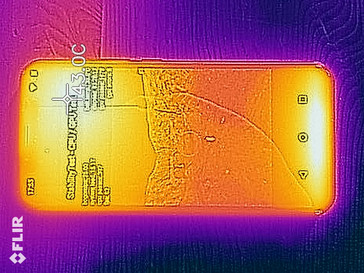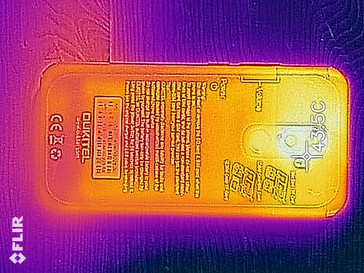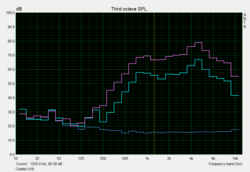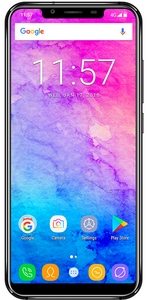Oukitel U18 Smartphone Review
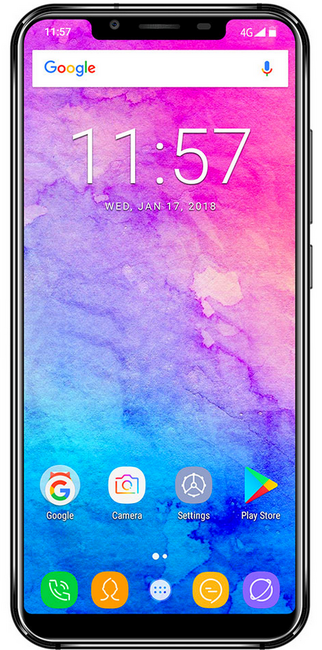
Just from its overall look you would never be able to tell that the U18, which has clearly been inspired by the Apple iPhone X and the Huawei Mate 10 Pro, is a smartphone from the 130 to 150-Euro (~$204-236) price range. This is because the Chinese manufacturer opts for a modern, bezel-less design. The smartphone features a 5.85-inch, 21:9 IPS display with a resolution of 1512x720. The display is also “adorned” with the rounded edges at the top and the bottom.
Analogous to the similarly-looking smartphones from Cupertino and Shenzhen, the mid-range device from Oukitel also sports a dual-camera set-up on its back. The Oukitel smartphone can be unlocked via “Face ID”, thanks to its 13 MP front-facing camera, and it also has a fingerprint scanner on the back.
The Oukitel U18 has a total of 4 GB of RAM and 64 GB of internal storage at its disposal. The storage capacity can be increased by up to 64 GB with a Micro SD card. The smartphone is powered by the MediaTek 6750T, whose eight cores can reach up to 1.5 GHz.
The competition in this price range is intense, and some imported smartphones in particular can offer partially better specs. These include: the Bluboo S8, the Leagoo Kiicaa Mix and the Doogee BL5000. There are also local competitors such as the Nokia 5 and the BQ Aquaris V to consider as well as the Huawei Y6 Pro 2017. All of the above-mentioned devices are viable competitors, which we have included in this review for comparison purposes.
Case - Thick Oukitel mobile
The case of the Oukitel U18 is composed of glass as well as a plastic back cover. The smartphone’s case is very rigid, thanks to its metal edges, which surely make a considerable contribution to the overall weight of the device, which amounts to a cool 214 grams. The non-removable plastic back cover does not bend easily but is somewhat slippery. The smartphone feels very good in the hand, despite its thickness of 10 mm and its high weight.
The rounded edges of the U18 can be described as relatively thin. That being said, the smartphone offers only a moderate screen-to-body ratio of 78%, due to its large top and bottom lips. However, when compared to the rest of the competition in this price range, such a result looks quite good.
The build quality is absolutely satisfactory, even though the power button and the volume rocker are quite wobbly. That being said, the power button and the volume rocker do have very clear actuation points.
Connectivity - HotKnot instead of NFC
The Oukitel U18 does not have an NFC chip and instead features MediaTek’s own HotKnot solution. The proprietary MediaTek technology functions similarly to NFC - when two devices with imbedded HotKnot chips come into contact with each other, data transfer is made possible.
The amount of eMMC storage space (64 GB) that the Oukitel U18 offers is actually pretty generous for a mid-range device. However, only 51 GB is available to the user, the rest is occupied by the OS. Moreover, the storage capacity can be increased by up to 64 GB with the help of a Micro SD card, and both internal and external storage can also be merged.
The device uses a USB Type-C port on the bottom for charging. However, this port can only run at USB 2.0 speeds. The port also supports On-The-Go (OTG) functionality, which means you can connect an external storage device or a keyboard to the smartphone. Other connectivity features include: FM radio, Miracast and support for wireless-streaming. Casting screen content to a Sony Android TV works flawlessly.
Software - Stock Android without notch optimization
The Oukitel U18 runs Android 7.0 Nougat with the January 2018 security patch. Because Android 7.0 does not feature native support for a notch you cannot pull down the notification shade when you slide your finger down the notch. Whether there will be an update to Android 8.1 and whether this update will include native support for the notch is unclear.
Another “problem” with the notch is that it “occupies” the area of the screen that is typically reserved for system notifications. So there is not enough space for such notifications. After all, there is barely enough space for the battery, Wi-Fi and signal indicators.
The U18 comes with a nearly stock Android skin. Other software functions such as three-finger screen-shot, one-handed mode and gesture control are also installed. However, the settings menu for gesture control functionality is rendered in English, even though our system language is set to German.
Communication and GPS - LTE Band 20 is supported
The U18 features Bluetooth 4.2. The integrated Wi-Fi module supports the IEEE 802.11 a/b/g/n (dual-band) standards and operates in the 2.4 and 5 GHz spectral bands. The range as well as signal stability are quite average. In close proximity to our router (Telekom Speedport, W921V), the signal attenuation amounts to -46 dBm.
The data transfer speeds between the smartphone and our reference-grade router, Linksys EA 8500, are very good. The transfer rates of over 100 Mbit/s are quite impressive for a device with this price tag. Moreover, the transfer rates remained constant over the course of our Wi-Fi test.
For wireless communication, the Oukitel smartphone supports GSM (quad-band), UMTS (dual-band) and LTE. All in all, the number of supported frequency bands is comparatively low. Thanks to dual SIM functionality, you can use two nano SIM cards at the same time. Both SIM-card slots feature support for LTE. Unusually for an imported device, the Oukitel U18 supports LTE band 20 (800 MHz), which is of particular importance to those who reside in rural areas in Germany.
| Networking | |
| iperf3 transmit AX12 | |
| HTC U11 Plus | |
| BQ Aquaris V | |
| Nokia 5 | |
| Oukitel U18 | |
| Doogee BL5000 | |
| Huawei Y6 Pro 2017 | |
| Bluboo S8 | |
| Leagoo Kiicaa Mix | |
| iperf3 receive AX12 | |
| HTC U11 Plus | |
| BQ Aquaris V | |
| Nokia 5 | |
| Oukitel U18 | |
| Doogee BL5000 | |
| Huawei Y6 Pro 2017 | |
| Leagoo Kiicaa Mix | |
| Bluboo S8 | |
The device uses Assisted GPS (aGPS) and GLONASS for geolocation. Outdoors, the U18 takes some time to determine your location and exhibits a margin of error of four meters. Indoors, even a weak signal is enough to acquire a location with a margin of error of three meters. We also took the smartphone with us on a nine-kilometer bike ride, after which we compared the results of the U18 to those of the professional navigator Garmin Edge 500 to see just how accurate they are. All in all, there was a 150-meter discrepancy between the two devices, which is not a bad result for a device in this price range. This kind of performance should be more than sufficient for navigation with a car or bicycle.
Telephony and Call Quality - Oukitel U18 impresses
Cameras - Oukitel smartphone with a dual-camera set-up
The main camera features the Sony IMX135 CMOS image sensor with a resolution of 16 MP (3456x4608). The f/2.0 aperture in our review device ensures that the images look bright and well-detailed when shot under good lighting conditions. However, the focus is not very precise and the dynamic range could have been wider as well. There is also an additional 5 MP camera on the back, the purpose of which we were unable to determine. It is not used for zooming and the depth-of-field effect works well even when the small 5 MP camera is covered up.
Nevertheless, the image quality is still good for a device with this price tag. The sharpness (see the test chart) and the color reproduction are okay and the shutter speed is also in good order. However, under poor lighting conditions, the auto-focus reaches its limit and the images appear blurry and lack definition.
The front-facing camera has a resolution of 8 MP, which can be interpolated up to 13 MP, and it has an f/2.8 aperture. The picture quality of the Galaxy Core GC80254 image sensor is disappointing. The images are often noisy and lack sharpness most of the time. It can record 720p video at 30 FPS. The rear camera can shoot video in 1080p at 30 FPS.
Accessories and Warranty - Standard fare
The box contains the device itself, a quick-start guide, a wall wart as well as a USB charging cable and a headphone jack adapter. Moreover, there is also a transparent plastic case from Oukitel in the box. The box does not contain a USB Type-C headset.
The Chinese manufacturer provides a 12-month international warranty for its device. You can learn here what to watch out for when buying a smartphone from foreign firms. Please see our Guarantees, Return Policies and Warranties FAQ for country-specific information.
Input Devices and Handling - Unnecessary restrictions
The Oukitel U18 is controlled via the standard Android on-screen buttons such as the “Back” button, the “Overview” button and the “Home” button. The capacitive touchscreen works well and can register up to five inputs at the same time. Straight out of the box, the smartphone uses the stock Android keyboard.
The fingerprint scanner on the back works fast but not very reliably. Moreover, it takes a while for the screen to turn on after you wake the device from stand-by mode. Besides the fingerprint reader, you can also use the face ID feature to unlock the smartphone, which works surprisingly well even in poor lighting conditions. The fact that you cannot use both options at the same time is quite puzzling. The ability to use the two security features at the same time would have brought additional value to the smartphone. Oukitel should rectify this situation via a software update.
Display - Bright but not evenly-lit
The U18’s 5.85-inch display has a resolution of 1512x720 and an aspect ratio of 21:9. This leads to a pixel density of 285 ppi. This is why the screen content does not look very sharp. However, this resolution is more than sufficient for day-to-day use.
The maximum brightness (565 cd/m²) is very high. However, the brightness distribution of 83% is very poor. When you enable the adaptive brightness feature, the display brightness actually reaches 613 cd/m².
The black value of 0.55 cd/m² is somewhat high for an IPS panel. The panel has a contrast ratio of 1:1027. The realistically-oriented APL50 test pattern, which consists of evenly distributed dark and bright areas, turns in a maximum brightness of 570 cd/m² and a black value of 0.56 cd/m². This corresponds to a good contrast ratio of 1:1018.
| |||||||||||||||||||||||||
Brightness Distribution: 83 %
Center on Battery: 565 cd/m²
Contrast: 1027:1 (Black: 0.55 cd/m²)
ΔE ColorChecker Calman: 7.1 | ∀{0.5-29.43 Ø4.77}
ΔE Greyscale Calman: 6.2 | ∀{0.09-98 Ø5}
Gamma: 2.85
CCT: 7153 K
| Oukitel U18 LCD IPS, 1512x720, 5.9" | Bluboo S8 IPS, 1440x720, 5.7" | Leagoo Kiicaa Mix IPS, 1920x1080, 5.5" | Doogee BL5000 IPS, 1920x1080, 5.5" | Huawei Y6 Pro 2017 IPS, 1280x720, 5" | Nokia 5 IPS, 1280x720, 5.2" | BQ Aquaris V IPS, 1280x720, 5.2" | HTC U11 Plus Super LCD 6, 2880x1440, 6" | |
|---|---|---|---|---|---|---|---|---|
| Screen | -6% | 11% | -23% | 9% | 12% | 17% | 33% | |
| Brightness middle (cd/m²) | 565 | 544.2 -4% | 441 -22% | 519 -8% | 393 -30% | 630 12% | 578 2% | 361 -36% |
| Brightness (cd/m²) | 535 | 539 1% | 444 -17% | 506 -5% | 388 -27% | 635 19% | 583 9% | 356 -33% |
| Brightness Distribution (%) | 83 | 95 14% | 91 10% | 89 7% | 90 8% | 90 8% | 91 10% | 90 8% |
| Black Level * (cd/m²) | 0.55 | 0.67 -22% | 0.44 20% | 0.52 5% | 0.42 24% | 0.57 -4% | 0.49 11% | 0.21 62% |
| Contrast (:1) | 1027 | 812 -21% | 1002 -2% | 998 -3% | 936 -9% | 1105 8% | 1180 15% | 1719 67% |
| Colorchecker dE 2000 * | 7.1 | 7.4 -4% | 4.1 42% | 9.1 -28% | 5.8 18% | 5 30% | 5.4 24% | 2.5 65% |
| Colorchecker dE 2000 max. * | 13.7 | 10.8 21% | 8.8 36% | 19.6 -43% | 8.7 36% | 8.7 36% | 9.1 34% | 5.3 61% |
| Greyscale dE 2000 * | 6.2 | 8.1 -31% | 4.9 21% | 12.7 -105% | 3 52% | 6.9 -11% | 4.3 31% | 1.7 73% |
| Gamma | 2.85 77% | 2.01 109% | 2.36 93% | 2.34 94% | 2.31 95% | 2.37 93% | 2.13 103% | 2.21 100% |
| CCT | 7153 91% | 8989 72% | 7549 86% | 9611 68% | 7060 92% | 8736 74% | 7400 88% | 6580 99% |
* ... smaller is better
Screen Flickering / PWM (Pulse-Width Modulation)
| Screen flickering / PWM not detected | |||
In comparison: 53 % of all tested devices do not use PWM to dim the display. If PWM was detected, an average of 8083 (minimum: 5 - maximum: 343500) Hz was measured. | |||
The picture quality of the IPS panel seems pretty impressive during normal use: Screen content is rich in contrast and the colors look good as well. However, objective measurements paint a slightly different picture: According to our colorimeter, which runs SpectraCal's CalMAN software, the U18’s display is on the “cool" side with a color temperature of 7153 K (6500 K is the ideal). Furthermore, the DeltaE 2000 deviations for both the grayscale (6.2) and the colors (7.1) are also quite strong (DeltaE less than 3 is the desired value). That being said, these figures are perfectly satisfactory for a smartphone in this price range.
Display Response Times
| ↔ Response Time Black to White | ||
|---|---|---|
| 15.6 ms ... rise ↗ and fall ↘ combined | ↗ 4.8 ms rise | |
| ↘ 10.8 ms fall | ||
| The screen shows good response rates in our tests, but may be too slow for competitive gamers. In comparison, all tested devices range from 0.1 (minimum) to 240 (maximum) ms. » 36 % of all devices are better. This means that the measured response time is better than the average of all tested devices (20.2 ms). | ||
| ↔ Response Time 50% Grey to 80% Grey | ||
| 42.8 ms ... rise ↗ and fall ↘ combined | ↗ 21.6 ms rise | |
| ↘ 21.2 ms fall | ||
| The screen shows slow response rates in our tests and will be unsatisfactory for gamers. In comparison, all tested devices range from 0.165 (minimum) to 636 (maximum) ms. » 70 % of all devices are better. This means that the measured response time is worse than the average of all tested devices (31.6 ms). | ||
Thanks to the high brightness of the LCD display, screen content is quite readable under the open sky, even when you are standing in direct sunlight. As is often the case, the viewing angles of the IPS panel are very good. When viewed from the sides or the top/bottom, the display loses a little bit of brightness. However, at acute angles, screen content becomes marred by a bluish or a yellowish cast.
Performance - Oukitel’s phone is on the same level as the competition
The Oukitel U18 is based on a 64-bit MediaTek MT6750 from 2016 and has 4 GB of RAM at its disposal. The clock rates of the eight Cortex A53 cores can reach up to 1.5 GHz in performance mode and up to 1 GHz in energy-saving mode. The ARM-based Mali-T860 MP2 serves as the GPU and features a maximum core clock of 520 MHz.
During normal use, the MT6750 provides a pretty good user experience. When you navigate through the system menus, nothing seems to lag or stutter and the experience, in general, is pretty smooth. However, once the processor is taxed, the device starts lagging, stuttering and freezing, especially when opening apps. Over the course of our review, a number of apps spat out various error messages, which went away after restarting the device. The benchmark results of the Oukitel U18 are on the same level as those of the competition.
| AnTuTu v6 - Total Score (sort by value) | |
| Bluboo S8 | |
| Leagoo Kiicaa Mix | |
| Doogee BL5000 | |
| Huawei Y6 Pro 2017 | |
| Nokia 5 | |
| BQ Aquaris V | |
| HTC U11 Plus | |
| Average Mediatek MT6750 (38547 - 44842, n=17) | |
| PCMark for Android | |
| Work performance score (sort by value) | |
| Oukitel U18 | |
| Doogee BL5000 | |
| Huawei Y6 Pro 2017 | |
| Nokia 5 | |
| BQ Aquaris V | |
| HTC U11 Plus | |
| Average Mediatek MT6750 (3667 - 4532, n=13) | |
| Work 2.0 performance score (sort by value) | |
| Oukitel U18 | |
| Bluboo S8 | |
| Leagoo Kiicaa Mix | |
| Doogee BL5000 | |
| Huawei Y6 Pro 2017 | |
| Nokia 5 | |
| BQ Aquaris V | |
| HTC U11 Plus | |
| Average Mediatek MT6750 (2782 - 3394, n=17) | |
| GFXBench 3.0 | |
| on screen Manhattan Onscreen OGL (sort by value) | |
| Oukitel U18 | |
| Doogee BL5000 | |
| Huawei Y6 Pro 2017 | |
| Nokia 5 | |
| BQ Aquaris V | |
| HTC U11 Plus | |
| Average Mediatek MT6750 (5.6 - 13, n=17) | |
| Average of class Smartphone (18 - 166, n=157, last 2 years) | |
| 1920x1080 1080p Manhattan Offscreen (sort by value) | |
| Oukitel U18 | |
| Doogee BL5000 | |
| Huawei Y6 Pro 2017 | |
| Nokia 5 | |
| BQ Aquaris V | |
| HTC U11 Plus | |
| Average Mediatek MT6750 (5.3 - 7.1, n=17) | |
| Average of class Smartphone (12 - 606, n=156, last 2 years) | |
| GFXBench 3.1 | |
| on screen Manhattan ES 3.1 Onscreen (sort by value) | |
| Oukitel U18 | |
| Doogee BL5000 | |
| Nokia 5 | |
| BQ Aquaris V | |
| HTC U11 Plus | |
| Average Mediatek MT6750 (3.8 - 10, n=17) | |
| Average of class Smartphone (11 - 166, n=157, last 2 years) | |
| 1920x1080 Manhattan ES 3.1 Offscreen (sort by value) | |
| Oukitel U18 | |
| Doogee BL5000 | |
| Nokia 5 | |
| BQ Aquaris V | |
| HTC U11 Plus | |
| Average Mediatek MT6750 (3.5 - 4.7, n=17) | |
| Average of class Smartphone (8.4 - 413, n=156, last 2 years) | |
Browsing the Internet with Chrome does not present any problems. However, all devices in this price range suffer from long loading times when surfing the web. When compared to the competition, the benchmark results of the U18 look quite average.
| JetStream 1.1 - Total Score | |
| HTC U11 Plus (Chrome 63) | |
| Nokia 5 (Chrome 56.0.2924.87) | |
| Doogee BL5000 (Chrome Version 61) | |
| Bluboo S8 (Chrome 62.0.3202.84) | |
| Oukitel U18 (Chrome 65) | |
| Leagoo Kiicaa Mix (Chrome 61.03163.98) | |
| Huawei Y6 Pro 2017 (Chrome Version 61) | |
| BQ Aquaris V (Chrome 63) | |
| Average Mediatek MT6750 (12 - 20.8, n=19) | |
| Octane V2 - Total Score | |
| Average of class Smartphone (2228 - 126661, n=195, last 2 years) | |
| HTC U11 Plus (Chrome 63) | |
| Oukitel U18 (Chrome 65) | |
| BQ Aquaris V (Chrome 63) | |
| Bluboo S8 (Chrome 62.0.3202.84) | |
| Nokia 5 (Chrome 56.0.2924.87) | |
| Average Mediatek MT6750 (1994 - 3506, n=19) | |
| Leagoo Kiicaa Mix (Chrome 61.03163.98) | |
| Huawei Y6 Pro 2017 (Chrome Version 61) | |
| Doogee BL5000 (Chrome Version 61) | |
| Mozilla Kraken 1.1 - Total | |
| Oukitel U18 (Chrome 65) | |
| Average Mediatek MT6750 (11708 - 22627, n=19) | |
| Bluboo S8 (Chrome 62.0.3202.84) | |
| Doogee BL5000 (Chrome Version 61) | |
| BQ Aquaris V (Chrome 63) | |
| Leagoo Kiicaa Mix (Chrome 61.03163.98) | |
| Huawei Y6 Pro 2017 (Chrome Version 61) | |
| Nokia 5 (Chrome 56.0.2924.87) | |
| HTC U11 Plus (Chrome 63) | |
| Average of class Smartphone (257 - 28190, n=155, last 2 years) | |
* ... smaller is better
The read and write rates of the Oukitel U18’s internal storage are not very high. Here, the write speed amounts to 109 MB/s and the read speed is 273 MB/s. Nevertheless, these are good figures for a device with eMMC memory. The SD card reader also offers good speeds when it comes to reading and writing data. We measure the read and write rates of an SD card reader with our reference-grade SD card Toshiba Exceria Pro M401. Here, the Oukitel U18 turns in a read speed of 95 MB/s and a write speed of 80 MB/s. These are good results when compared to the rest of the competition.
| Oukitel U18 | Bluboo S8 | Leagoo Kiicaa Mix | Doogee BL5000 | Huawei Y6 Pro 2017 | Nokia 5 | BQ Aquaris V | HTC U11 Plus | Average 64 GB eMMC Flash | Average of class Smartphone | |
|---|---|---|---|---|---|---|---|---|---|---|
| AndroBench 3-5 | 5% | 21% | 36% | -6% | 3% | 3% | 263% | 61% | 1466% | |
| Sequential Read 256KB (MB/s) | 273.1 | 281 3% | 251.2 -8% | 274.8 1% | 143.4 -47% | 255.6 -6% | 266.3 -2% | 728 167% | 277 ? 1% | 2248 ? 723% |
| Sequential Write 256KB (MB/s) | 109.2 | 77.6 -29% | 131.2 20% | 171.4 57% | 50.7 -54% | 74.9 -31% | 76.7 -30% | 207.9 90% | 178.4 ? 63% | 1887 ? 1628% |
| Random Read 4KB (MB/s) | 28.7 | 38.24 33% | 52.3 82% | 57.4 100% | 45.65 59% | 40.54 41% | 33.7 17% | 132.4 361% | 60.7 ? 111% | 299 ? 942% |
| Random Write 4KB (MB/s) | 12.96 | 12.37 -5% | 13.95 8% | 11.29 -13% | 6.78 -48% | 8.39 -35% | 10.9 -16% | 135.7 947% | 33.8 ? 161% | 346 ? 2570% |
| Sequential Read 256KB SDCard (MB/s) | 71.5 ? | 75.9 6% | 78 9% | 83.4 ? 17% | 83.9 17% | 83.6 ? 17% | 75.4 ? 5% | 77.4 ? 8% | ||
| Sequential Write 256KB SDCard (MB/s) | 47.02 ? | 55.9 19% | 54.4 16% | 64.1 ? 36% | 62 32% | 60.8 ? 29% | 51.3 ? 9% | 58.3 ? 24% |
Gaming - Some demanding 3D games are playable
The Mali-T860 MP2 supports OpenGL ES 3.1 and OpenCL 1.1 as well as DirectX 11. Some demanding 3D games from the Google Play Store are playable. However, when playing more demanding video games, lags and stutters are common. When we were benchmarking the racing game Asphalt, we noticed quite a bit of stuttering. The U18’s graphics unit achieves an average frame rate of 29 FPS in Asphalt 8 Airborne as well as 51 FPS in Dead Trigger 2.
The touchscreen as well as the motion sensor worked well during our gaming benchmarks. The high weight of the device proved to be quite a drag during long gaming sessions, though.
Emissions - Warm Oukitel phone
Temperature
The surface temperatures never reach critical levels. Nevertheless, the Oukitel U18 still gets pretty toasty under sustained load. Under continuous load, the device hits a temperature of 42 °C (107.6 °F) on the back. That being said, the smartphone never feels uncomfortably hot in the hand, even when gaming.
(±) The maximum temperature on the upper side is 42.3 °C / 108 F, compared to the average of 35.2 °C / 95 F, ranging from 21.9 to 247 °C for the class Smartphone.
(±) The bottom heats up to a maximum of 42.2 °C / 108 F, compared to the average of 34 °C / 93 F
(+) In idle usage, the average temperature for the upper side is 31.2 °C / 88 F, compared to the device average of 32.9 °C / 91 F.
Speakers
With 84 dB(A), the maximum volume of the mono-speaker is sufficiently loud. Nevertheless, the sound quality on offer is well below average and extremely unbalanced. Our sound graph shows that the bass is almost completely missing and that the entire audible range is far from being linear. What this means is that if you decide to listen to music, especially at a high volume, you will get a distorted, bass-less, tinny sound. Most other competitors in this price range manage to do better in this department.
Oukitel U18 audio analysis
(+) | speakers can play relatively loud (84 dB)
Bass 100 - 315 Hz
(-) | nearly no bass - on average 35.8% lower than median
(±) | linearity of bass is average (9.9% delta to prev. frequency)
Mids 400 - 2000 Hz
(+) | balanced mids - only 4.6% away from median
(±) | linearity of mids is average (7.4% delta to prev. frequency)
Highs 2 - 16 kHz
(±) | higher highs - on average 5.8% higher than median
(+) | highs are linear (6.6% delta to prev. frequency)
Overall 100 - 16.000 Hz
(±) | linearity of overall sound is average (26.9% difference to median)
Compared to same class
» 69% of all tested devices in this class were better, 5% similar, 26% worse
» The best had a delta of 11%, average was 35%, worst was 134%
Compared to all devices tested
» 82% of all tested devices were better, 4% similar, 14% worse
» The best had a delta of 4%, average was 24%, worst was 134%
Huawei Y6 Pro 2017 audio analysis
(+) | speakers can play relatively loud (85.3 dB)
Bass 100 - 315 Hz
(-) | nearly no bass - on average 33.8% lower than median
(+) | bass is linear (4.9% delta to prev. frequency)
Mids 400 - 2000 Hz
(±) | reduced mids - on average 6% lower than median
(±) | linearity of mids is average (8.6% delta to prev. frequency)
Highs 2 - 16 kHz
(±) | higher highs - on average 5.8% higher than median
(+) | highs are linear (6.5% delta to prev. frequency)
Overall 100 - 16.000 Hz
(±) | linearity of overall sound is average (25.8% difference to median)
Compared to same class
» 64% of all tested devices in this class were better, 6% similar, 29% worse
» The best had a delta of 11%, average was 35%, worst was 134%
Compared to all devices tested
» 79% of all tested devices were better, 4% similar, 17% worse
» The best had a delta of 4%, average was 24%, worst was 134%
Frequency diagram in comparison (checkboxes can be checked and unchecked!)
Battery Life - Not impressive when compared to the competition
Energy Consumption
The Oukitel U18 does not shine when it comes to energy management under load. When compared to the rest of the competition, the U18 draws an astonishing amount of power. With over 12 watts, the maximum power consumption of the Oukitel U18 is higher than that of the HTC U11 Plus with a Snapdragon 835 SoC.
| Off / Standby | |
| Idle | |
| Load |
|
Key:
min: | |
| Oukitel U18 4000 mAh | Bluboo S8 3450 mAh | Leagoo Kiicaa Mix 3000 mAh | Doogee BL5000 5050 mAh | Huawei Y6 Pro 2017 3020 mAh | Nokia 5 3000 mAh | BQ Aquaris V 3100 mAh | HTC U11 Plus 3930 mAh | |
|---|---|---|---|---|---|---|---|---|
| Power Consumption | 12% | 2% | 7% | 34% | 46% | 43% | 41% | |
| Idle Minimum * (Watt) | 1.12 | 1.6 -43% | 2 -79% | 1.44 -29% | 0.6 46% | 0.52 54% | 0.71 37% | 0.51 54% |
| Idle Average * (Watt) | 2.27 | 2.4 -6% | 2.5 -10% | 2.9 -28% | 2.02 11% | 1.78 22% | 1.82 20% | 1.62 29% |
| Idle Maximum * (Watt) | 2.49 | 2.5 -0% | 2.9 -16% | 3 -20% | 2.08 16% | 1.96 21% | 1.84 26% | 1.87 25% |
| Load Average * (Watt) | 10.75 | 6.5 40% | 6.1 43% | 4.55 58% | 5.31 51% | 3.23 70% | 3.12 71% | 3.92 64% |
| Load Maximum * (Watt) | 12.39 | 4 68% | 3.3 73% | 5.4 56% | 6.41 48% | 4.88 61% | 5.13 59% | 8.27 33% |
* ... smaller is better
Battery Life
The battery capacity of 4000 mAh is pretty big for a compact smartphone. Nevertheless, the energy consumption under load has got to be optimized if the smartphone is to achieve long battery life. In our practically-oriented Wi-Fi test, the U18 achieves a good battery runtime of 10 hours and 39 minutes. However, this result is not very impressive considering the battery capacity and the hardware.
| Oukitel U18 4000 mAh | Bluboo S8 3450 mAh | Leagoo Kiicaa Mix 3000 mAh | Doogee BL5000 5050 mAh | Huawei Y6 Pro 2017 3020 mAh | Nokia 5 3000 mAh | BQ Aquaris V 3100 mAh | HTC U11 Plus 3930 mAh | |
|---|---|---|---|---|---|---|---|---|
| Battery runtime | ||||||||
| WiFi v1.3 (h) | 10.7 | 6.5 -39% | 4.3 -60% | 18.4 72% | 11.1 4% | 11.9 11% | 11.5 7% | 10.1 -6% |
Pros
Cons
Verdict - The Chinese phone fails to really impress when compared to the competition
The Oukitel U18 scores major points with its modern design and good build quality. The low-priced mid-range smartphone looks quite compact because of the aspect ratio of its display (21:9). However, because of its thickness of 10 mm and the high weight, not every user will be happy with how the Oukitel U18 feels in the hand.
Without fail, when looking at the Oukitel U18 one particular question arises: Why did the Chinese manufacturer put a notch at the top of the display when a pretty big chin bar is available at the bottom? This causes not only “visual (esthetic)” problems but also actual ones such as the lack of notification icons for missed calls and the like.
Those who like the U18’s design and see the notch as a reason to buy should give Oukitel’s device a closer look.
Design is the only thing that distinguishes the Oukitel smartphone from the rest of the competition. Moreover, the Oukitel device offers a worse software experience than most other competitors in this price range. All in all, the U18 is not a bad smartphone. However, in light of the locally-available offerings such as the Nokia 5 or the BQ Aquaris V, prospective buyers should really consider whether the risks and restrictions of buying an imported smartphone are really worth it.
Oukitel U18
- 03/29/2018 v6 (old)
Marcus Herbrich


